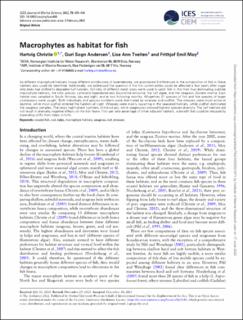Macrophytes as habitat for fish
Peer reviewed, Journal article
Published version
Permanent lenke
https://hdl.handle.net/11250/3004652Utgivelsesdato
2022Metadata
Vis full innførselSamlinger
- Publikasjoner fra Cristin - NIVA [2148]
- Scientific publications [1172]
Sammendrag
As different macrophyte habitats house different distributions of invertebrates, we questioned if differences in the composition of fish in these habitats also could be identified. Additionally, we addressed the question if the fish communities could be affected a few years after sugar kelp beds had shifted to degraded turf habitats. Gill-nets of different mesh sizes were used to catch fish in the then four dominating subtidal macrophyte habitats; the kelp species Laminaria hyperborea and Saccharina latissima, the turf algae, and the seagrass Zostera marina. Each habitat was sampled in South Norway, day and night, and at two following months. Altogether, 31 species of fish and five species of larger crustaceans were caught. Both individuals and species numbers were dominated by wrasses and codfish. The wrasses were most active at daytime, while most codfish entered the habitats at night. Wrasses were mainly occurring in the seaweed habitats, while codfish dominated the seagrass samples. The kelps had highest numbers of individuals, while seagrasses showed highest species diversity. The turf habitats did not result in dramatic negative effects on the fish fauna. Fish can take advantage of other adjacent habitats, a benefit that could be reduced by expanding shifts from kelps to turfs.

